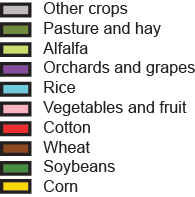Chlorpyrifos
klawr-pir-uh-fos
Widely used in U.S. agriculture. Registered as a U.S. pesticide in 1965. Reregistered in 2006. Banned for indoor residential use since 2000. Proposed revocation of food tolerances in 2015. EPA refused multiple times to ban chlorpyrifos. Through a series of lawsuits, Earthjustice pushed EPA to ban chlorpyrifos. In 2021, EPA finally issued a final rule banning all food uses of chlorpyrifos. The 8th Circuit vacated the agency's rule on Nov. 2, 2023. Read an explainer and in-depth report on chlorpyrifos.
Overview
Chlorpyrifos is used in the 48 contiguous states.

Data is not available for Alaska, D.C., Hawaiʻi, and U.S. Territories. Data represents the most recent year available from USGS. Details.
Caliornia, Hawaii, New York, and Oregon have moved to ban chlorpyrifos. The U.S. EPA issued a final rule on Aug. 18, 2021, to ban all food uses of chlorpyrifos. The 8th Circuit vacated the agency's rule on Nov. 2, 2023.
See detailed maps of chlorpyrifos usage by state and county.
Human Health Effects
Even at low levels of exposure, chlorpyrifos can lead to serious negative health effects.
Neurodevelopmental Harm
Reproductive Toxicity
High Risk Exposure Routes
People are exposed to chlorpyrifos through food and drinking water, even if they don’t live near areas where pesticides are sprayed. Details.
Food and/or Drinking Water
FarmworkersPeople performing post-application activities in previously treated fields, but do not directly apply pesticides themselves. Details.
Pesticide HandlersPeople involved in pesticide application process. Details.
ResidentialAlthough banned from nearly all residential uses, residential exposure to chlorpyrifos can happen through ant and roach baits. People can also come in contact following applications on turf golf courses or aerial mosquitocide.
Residential BystanderPeople who live near areas where pesticides are applied. Chlorpyrifos exposure route only of risk in 2016 Risk Assessment. Details.
Spray Drift
Wide Area Public Pest Control
High Residue Foods
Where residue levels of chlorpyrifos exceeded allowable limits or were not legally allowed to have residues. Details.
Basil
Cilantro
Raisins
Registered Uses
Where EPA allows chlorpyrifos to be used.
Agricultural Crops: alfalfa, corn, cotton, fruit and vegetables, orchards and grapes, soybeans, wheat, other crops
Cattle Ear Tags
Golf Courses
Greenhouses and Nurseries
Industrial Sites
Outdoor Ant Mounds
Outdoor Mosquito Fogger Adulticide
Residential Roach Bait
Sod Farms
Wood Products
Additional Information
Estimated Use of Chlorpyrifos on Crops
Most recent agricultural crop usage data as provided by the U.S. Geographical Survey’s Pesticide National Synthesis Project. Does not reflect universal usage of chlorpyrifos. (How do EPest-low and EPest-high differ?)
U.S. Tolerances Categories & Commodities for Chlorpyrifos
The U.S. EPA sets maximum residue limits — known as “tolerances” — on the amount of chlorpyrifos that may remain in and on foods. The tolerance is the residue level that triggers enforcement actions.
Tolerances have been set for chlorpyrifos for: Agricultural Commodities and Milk Eggs Meat and/or Poultry. Maximum residue limits have been set for chlorpyrifos by the U.S. EPA for the following commodities:
Almond
Apple
Asparagus
Banana
Beet
Cattle
Cherry
Citrus
Cotton
Cranberry
Cucumber
Egg
Fig
Goat
Grape
Hazelnut
Horse
Kiwifruit
Leafy Vegetables
Milk
Nectarine
Onion
Peach
Peanut
Pecan
Pepper
Peppermint
Plum
Poultry
Pumpkin
Radish
Rutabaga
Sorghum
Soybean
Spearmint
Strawberry
Sunflower
Sweet Potato
Turnip
Walnut
Wheat
U.S. EPA Human Health Risk Assessments for Chlorpyrifos
Human Health Risk Assessments are conducted by the U.S. EPA to estimate the nature and probability of harmful health effects in people who may be exposed to pesticide. They are used to make informed decisions about approving new pesticides and new uses of registered pesticides, and during our regular review of existing pesticides. Read the assessments for chlorpyrifos:
Special Note: Information pertaining to the organophosphate pesticide chlorpyrifos was obtained in part from EPA’s 2016 human health risk assessment, which is the most health protective recent human health risk assessment for chlorpyrifos.
Although EPA did also release a final human health risk assessment in 2014 and a subsequent updated version in 2020 that both found serious risks of concern for many uses of chlorpyrifos, including by workers, both versions relied on methodologies that underestimated risk to the developing fetus and therefore failed to protect children from neurodevelopmental harm at low levels of exposure.
In other words, the risks of concern arising from chlorpyrifos use are likely far greater and more pervasive than those identified in the 2014 and 2020 risk assessments. Thus, to more accurately reflect real-world risks and adhere to the most health protective risk determinations, this database only reflects information from the 2016 version.


